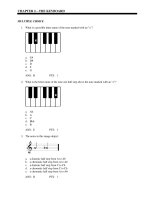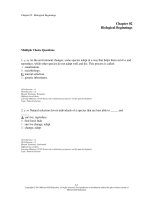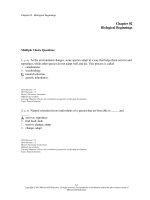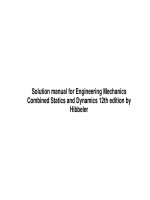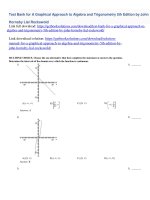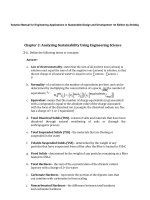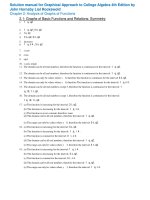Solutions manual for a creative approach to music fundamentals 10th edition by william duckworth
Bạn đang xem bản rút gọn của tài liệu. Xem và tải ngay bản đầy đủ của tài liệu tại đây (424.6 KB, 6 trang )
Solutions Manual for A Creative Approach to Music Fundamentals 10th
Edition by William Duckworth
Chapter 2: Rhythm I: Simple Meter
Suggestions
I tell my students that it is not enough to count rhythms in their heads—they must feel
them in their bodies as well. So I try to get them moving and actively involved as quickly
as possible. My thought is that anything I can do to break down their artificial mind/body
barrier will make them better musicians.
Understanding dotted notes is sometimes a problem for students. In class, I will often write
a rhythm that uses dotted notes on the board and ask the class to clap it. If they have trouble, I’ll ask half the class to clap steady eighth notes while the other half claps the rhythm.
If they still have trouble, I’ll write the steady eighth notes under the rhythmic pattern to
illustrate the relationship visually. I do it in this order, which may seem backwards to some
instructors, because I want them to feel (or at least attempt to feel) the relationship before
they see it.
I try to get my students using the Appendices as quickly and as often as possible. I have
found that the simple rhythms of Appendix A (pp. 301–305) is a good place to begin because
almost everyone in class can do them, and I encourage them to practice both inside and
outside of class.
I try to begin the two-part rhythms of Appendix B (pp. 306–309) as quickly as possible,
sometimes introducing the first two examples simultaneously with their introduction to
Appendix A. I tell them that music is a ―team sport‖ and that they need to be aware of the
problems of coordinating several different lines from the beginning.
Melody is the most elusive of all the musical elements. While we all know what one sounds
like, we have a lot of trouble saying what we like about it, or why it works so well. I have
found that the more tangible I can make a melody for my students, the more they relate to
it and begin to understand it. I try to have them sing something almost every class. Often,
it is the first melodic example I am planning to talk about. I’ve found that if I don’t make
singing an everyday occurrence, it becomes too exotic for most of them to try.
The voice is an instrument that every student has. The more we can get them to use it and
explore it, the more meaningful music, and the ideas in the text, will become.
17
© 2010 Cengage Learning. All Rights Reserved. May not be scanned, copied or duplicated, or posted to a publicly accessible website, in whole or in part.
18
Chapter 2: Rhythm I: Simple Meter
Somewhere during the section on melody, I always try to compare a western melody with
an non-western melody. Mostly we just listen to CDs and then reflect and comment on
them. I have found it particularly useful to juxtapose rock guitar solos with Indian sitar
music, or Eastern European singing with the styles of Broadway and Bach. My goal is
to make my students aware of both the differences and the similarities in styles and
techniques.
It is a good idea to get your students thinking of the Appendices as active parts of the bookthat contain both practice material and useful ancillary information. I’ve found that no
matter how fast or slow I go, there are always one or two students who like to read ahead.
I try to encourage them to explore the Appendices when I can.
Conducting as a group is not the same experience as conducting individually. So whenever
possible, I try to give my students conducting experience in front of the class. This can be
an easy song or rhythmic exercise from the text or, later in the semester, a melody they
have written. The point is to give them actual control over the sounds being produced.
Practice Sheets
SHEET 1
As a class, perform these two- and three-part rhythmic exercises. Be sure to keep the beat even.
1.
2.
© 2010 Cengage Learning. All Rights Reserved. May not be scanned, copied or duplicated, or posted to a publicly accessible website, in whole or in part.
Chapter 2: Rhythm I: Simple Meter
19
3.
Answers to Textbook Exercises
Practice Materials 2–1
1.
2.
3.
4.
5.
6.
7.
8.
9.
10.
© 2010 Cengage Learning. All Rights Reserved. May not be scanned, copied or duplicated, or posted to a publicly accessible website, in whole or in part.
20
Chapter 2: Rhythm I: Simple Meter
Practice Materials 2–2
1.
2.
3.
4.
5.
6.
7.
8.
Practice Materials 2–3
1.
2.
3.
4.
5.
6.
7.
© 2010 Cengage Learning. All Rights Reserved. May not be scanned, copied or duplicated, or posted to a publicly accessible website, in whole or in part.
Chapter 2: Rhythm I: Simple Meter
21
Practice Materials 2–4
1.
2.
3.
4.
© 2010 Cengage Learning. All Rights Reserved. May not be scanned, copied or duplicated, or posted to a publicly accessible website, in whole or in part.
22
Chapter 2: Rhythm I: Simple Meter
Practice Materials 2–4 (continued)
5.
6.
Practice Materials 2–5
1.
2.
3.
4.
5.
© 2010 Cengage Learning. All Rights Reserved. May not be scanned, copied or duplicated, or posted to a publicly accessible website, in whole or in part.

